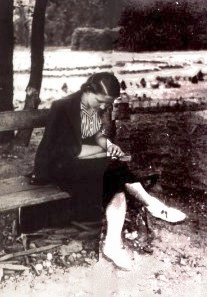

At the age of 9 or 10 Haika joined the local group of the
youth movement "Hashomer Hatza'ir" ("The Young Guards").
This was the youth movement of the political party Mapam, which today is part of
Meretz. It was the natural
thing to do: every good Jewish child saw Hashomer Hatza'ir as
a source of inspiration. The youth movement widened the education
she had received at school.
At the age of 15 or 16 the members of the movement were studying
Borochov, Marx, Freud, Schopenhauer and the new literature that
had been published between the two World Wars. The school of thought
studied and accepted in the movement was Hassidic. |
 in the town of Brisk. |
At the end of her high school studies, Haika was accepted to the
Hebrew University of Jerusalem. Through her family, she easily
obtained an immigration permit ("certificate"). But she was
already a member of the Central Committee of the Hashomer movement,
and instead of immigrating, she was sent to the Brisk area, to
organize the movement's activities in that region. Haika requested
again to be allowed to go to Israel, but the central committee
replied that she must stay in Poland. |
With the outbreak of war in 1939, the Grossman family opened its house in Bialystok to refugees and members of the movement. Some of the refugees continued on north-east to Vilna, far from the invading Nazi forces. Others went back to Warsaw, which was under Nazi occupation. In 1941, when the Nazis invaded the eastern areas of Poland, Haika stayed behind to organize the underground resistance. With her were Abba Kovner, Adam Borcas, Mordechai Rosman, Pinhas Stern and Moshe Belush. All the veteran members of the Central Committee, with the movement's permission or without it, left Vilna and immigrated to Israel in early 1941. |
|
 |
||
| Previous page | Next page | Home |